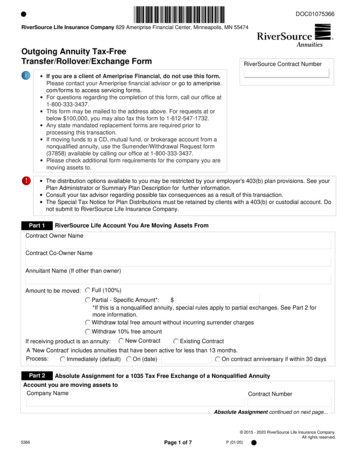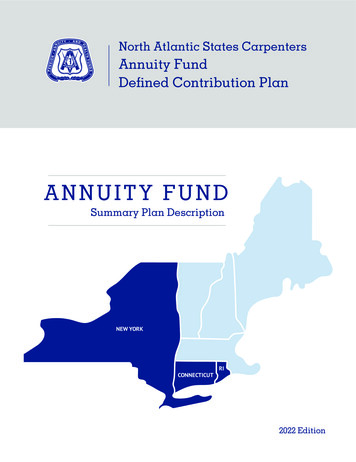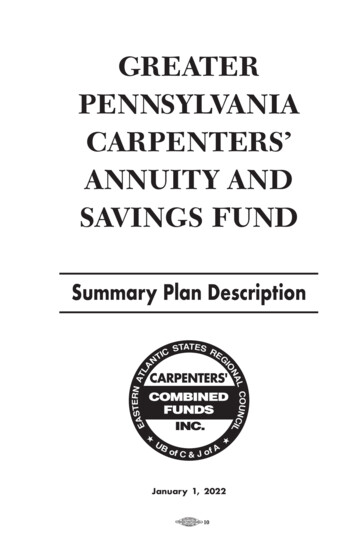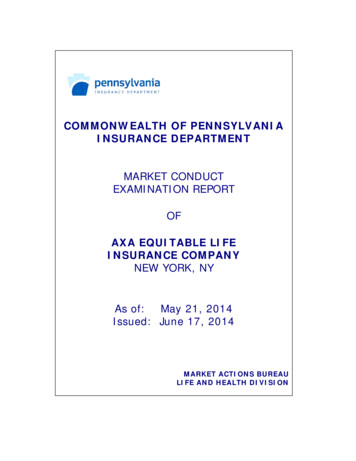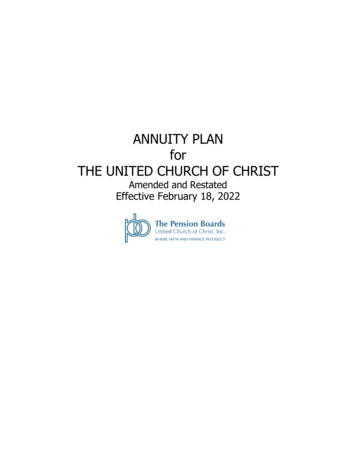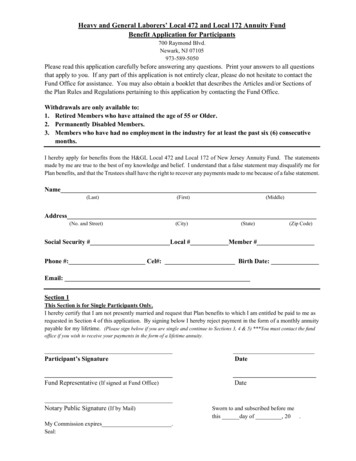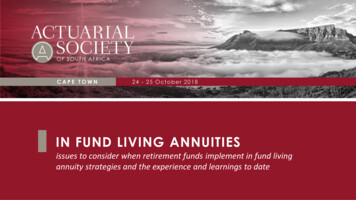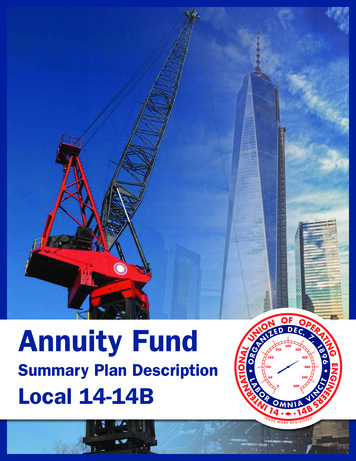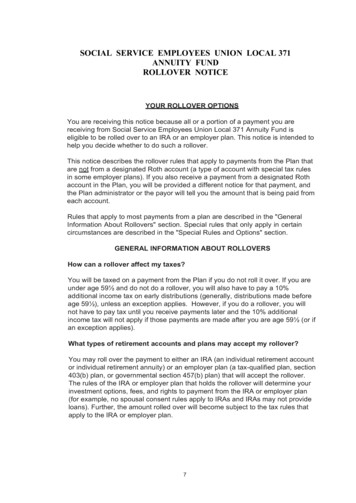
Transcription
Annuity Fund of Local One, I.A.T.S.E.Prepared USASM awaits you insure invest retire Retirement Services
Prepared USASMawaits you.It is a place, a destination.It is comfort and confidence, poise and peace-of-mind.It is knowing that you are taking positive steps toward reaching yourretirement goal.Regardless of which path to Prepared USA you choose, we can help you getthere with services customized to meet your level of investing expertise:I Know the WayI’d Like a MapShow Me the WayIf you’re a savvy, confidentinvestor, we’ll give you thetools you’ll need to take apath of your own choosing.Want a little guidance?We’ll help you plan yourroute, while making sureyou stay in control.If you’re more comfortabletraveling a proven trail, justtell us a little about yourself,and we can make it easierwith simpler choices.Let us help you get there!We’ll help you get there.SMFor investment options utilizing MassMutual as the investmentadvisor, MassMutual brings strong investment know-how andactively monitors each investment option in your retirementplan. MassMutual regularly oversees the fund companies andportfolio managers of those investment options, examiningthem on a variety of critical factors. In addition, these expertmanagers know that MassMutual demands adherence to thehighest ethical investing and business practices. We are aFortune 500 Company1 and rank fifth in the industry amongFortune’s Most Admired Companies in America2. With over150 years of experience and more than 360 billion in assetsunder management3, MassMutual offers an ideal combinationof stability, strength, and uncompromising standards.4 pplies to MassMutual Financial Group – FORTUNE Magazine,AMay 4, 20092 Applies to Massachusetts Mutual Life Insurance Company FORTUNE Magazine, May 4, 20093 Assets Under Management are as of 12/31/08 and include assets andcertain external investment funds managed by our subsidiaries.4Past performance does not guarantee future results.1
Annuity Fund of Local One, I.A.T.S.E.This booklet will help you better understand the Annuity Fund of Local One, I.A.T.S.E. and take fulladvantage of all its features.Think about this:Are you allocating your savings to the most appropriate investments for your age and risk tolerance? Thinkof your investments as the energy force that will help you plan for retirement and after. Go to FindYourself, Find Your Future and choose the path that will help you get to a place of peace-of-mind calledPrepared USA.C:06161-01MMF 003 (1/4)1.1
Benefits of Your PlanA Quick ReviewYour plan offers many advantages over other savings options. What you get out of the plandepends on how you invest your savings, how those investments perform, and how long you letthe plan work for you.1. The "Magic" of CompoundingEvery dollar that goes into the Plan has the potential to generate earnings, orgrow. Earnings on contributions can grow tax-deferred and can then generate moreearnings, and so on. Money making money; that’s the theory behind compounding.2. Investment ChoicesThe Plan offers a variety of high-quality investment options, so you can find the one, orcombination, that works for you.Investors should consider an investment's objectives, risks, charges and expenses carefully before investing.This and other information about the investment company is available in the applicable prospectus, availablefrom your plan sponsor or on The JourneySM. Read it carefully before investing.3. Savings for lifeYour vested account balance is designed to help you save for your retirement. Please referto your Summary Plan Description for details about when you will qualify for adistribution.Here’s a quick look at some of the plan’s features and benefits: The "Magic" of CompoundingEvery dollar that goes into the plan has the potential to generate earnings, or grow,including what you would have otherwise paid in taxes. Both pre-tax contributions andearnings on those contributions can grow tax-deferred and can then generate moreearnings, and so on. Money making money; that’s the theory of compounding. Savings for LifeYour vested account balance is always yours to take with you should you changeemployers.1.2
Getting ThereChecking on your account does not take a great deal of your time. Consider one main factor. Are you allocating your contributions to the most appropriate investments for your ageand risk tolerance? The types of investments you choose will determine how much yoursavings may be able to earn.Earning even a little more on your investments can make a difference. While there is an elementof risk in seeking a higher total return, there is also risk in not saving enough to meet yourretirement needs later in life.You don’t have to be a Wall Street wizard to make these important decisions. MassMutualprovides services to help you make sound choices for your retirement dollars.Today is the day to get started on your path to retirement.Excessive Trading PolicyMassMutual strongly discourages plan participants from engaging in excessive trading. TheMassMutual Excessive Trading Policy helps protect the interests of long-term investors likeyou. If you would like to view the MassMutual Excessive Trading Policy, please visit TheJourneySM, MassMutual’s participant Web site at www.massmutual.com/retire.In addition, you cannot transfer into any investment options if you have already made apurchase followed by a sale (redemption) involving the same investment within the last sixtydays. You may not request a transfer into international options between 2:30 and 4 p.m. ET.C:06161-01MMF 003 (2/4)1.3
InvestorProfile QuizTo helphelp determinedetermine youryour strategy,strategy, answeranswer thesethese questionsquestions byby circlingcircling thethe choiceschoices youyou mostmost s.ThenwritethetotalinSection3atthebottomwith. Add up the points for each of your choices. Then write the total in Section 3 at the bottomof thisthis page.page.of2. MyMy currentcurrent ageage is:is:2.a. UnderUnder 4040 . . . . . . . . . . . . . . . . . . . . . . . . . . . . . . . . 55a.b. 40–5440–54 . . . . . . . . . . . . . . . . . . . . . . . . . . . . . . . . . . 33b.c.55 andand overover . . . . . . . . . . . . . . . . . . . . . . . . . . . . . . 11c. 553.Iexpecttoretire:3. I expect to retire:a. NotNot forfor atat leastleast 2020 yearsyears . . . . . . . . . . . . . . . . . . . . 55a.b. InIn 55 toto 2020 yearsyears . . . . . . . . . . . . . . . . . . . . . . . . . . . 33b.c. WithinWithin 55 yearsyears . . . . . . . . . . . . . . . . . . . . . . . . . . . . 11c.SECTION 1:1: TIMETIME HORIZONHORIZONSECTION1. II planplan toto withdrawwithdraw mymy moneymoney inin 33 yearsyears oror lessless andand dodo1.notwanttoloseanyofit:not want to lose any of it:a. YesYesb. NoNoa.b.you answeredanswered “yes”“yes” toto questionquestion 1,1, setset youryour investmentinvestmentIfIf youcoursewithaSHORTTERMSTRATEGY.course with a SHORT TERM STRATEGY.SECTION 2:2: RISKRISK TOLERANCETOLERANCESECTIONShort-Term GoalsGoalsShort-Term6. WhichWhich ofof thesethese statementsstatements wouldwould bestbest describedescribe youryour6.attitude aboutabout thethe performanceperformance ofof thisthis portfolioportfolio overoverattitudethenextthreeyears?the next three years?a. II cancan livelive ifif II loselose money.money. . . . . . . . . . . . . . . . . . . . 55a.b.Ibetteratleastbreak-even.b. I better at least break-even. . . . . . . . . . . . . . . . . . . 33c. II betterbetter endend upup withwith atat leastleast aa littlelittle profit.profit. . . . . . . 11c.Long-Term GoalsGoalsLong-Term4. ForFor thisthis portfolio,portfolio, mymy goalgoal is:is:4.a.Togrowmyassetsaggressively.a. To grow my assets aggressively. . . . . . . . . . . . . . . 55b. ToTo growgrow mymy assetsassets withwith caution.caution. . . . . . . . . . . . . . . 33b.c. ToTo avoidavoid losinglosing money.money. . . . . . . . . . . . . . . . . . . . . . 11c.5. WhatWhat wouldwould II expectexpect fromfrom thisthis portfolioportfolio overover t.5a. To generally keep pace with the stock market . . . .5b.Tomakeadecentprofit,butprobablytrailb. To make a decent profit, but probably trailthe stockstock marketmarket . . . . . . . . . . . . . . . . . . . . . . . . . . .3.3thec.Tohaveahighdegreeofstability,butonlyc. To have a high degree of stability, but onlymodest profitsprofits . . . . . . . . . . . . . . . . . . . . . . . . . . . .1.1modest7. WhichWhich ofof thesethese statementsstatements wouldwould bestbest describedescribe youryour7.attitude aboutabout thethe performanceperformance ofof thisthis portfolioportfolio overoverattitudethe nextnext threethree months?months?thea. WhoWho cares?cares? OneOne calendarcalendar quarterquarter meansmeans nothingnothing . . .5.5a.b. IfIf II sufferedsuffered aa lossloss ofof greatergreater thanthan 10%,10%,b.I’d getget concernedconcerned . . . . . . . . . . . . . . . . . . . . . . . . . .3.3I’dc. II cancan toleratetolerate onlyonly smallsmall shortshort termterm losses.losses. . . . . . 11c.Financial SituationSituationFinancial8. IfIf II lostlost mymy jobjob tomorrow,tomorrow, II would:would:8.a. HaveHave otherother sourcessources ofof incomeincome toto lastlasta.me moremore thanthan sixsix months.months. . . . . . . . . . . . . . . . . . . . 55meb. HaveHave enoughenough cashcash onon handhand toto lastlastb.three toto sixsix months.months. . . . . . . . . . . . . . . . . . . . . . . . . 33threec. NeedNeed toto taptap intointo mymy retirementretirement investmentinvestment withinwithinc.30days.30 days. . . . . . . . . . . . . . . . . . . . . . . . . . . . . . . . . . 119. UponUpon retirementretirement mymy investmentinvestment willwill ya. A minor part (less than 25%) of myretirementincome.retirement income. . . . . . . . . . . . . . . . . . . . . . . . . . 55b.An importantimportant partpart (25%(25% –– 75%)75%) ofof mymyb. Anretirement income.income. . . . . . . . . . . . . . . . . . . . . . . . . 33retirementc. TheThe vastvast majoritymajority (over(over 75%)75%) ofof mymyc.retirement income.income. . . . . . . . . . . . . . . . . . . . . . . . . 11retirementSECTION 3:3: INVESTMENTINVESTMENT STRATEGYSTRATEGYSECTIONAdd upup youryour pointspoints fromfrom QuestionsQuestions 2-92-9 toto determinedetermine whichwhich investmentinvestment strategystrategy belowbelow isis bestbest forfor you.you.AddTOTAL POINTS0-89-1718-2728-3536-40INVESTMENT STRATEGYShort TermConservativeModerateAggressiveUltra AggressiveMY TOTAL:Based onon thisthis “investment“investment strategy,”strategy,” you’reyou’re readyready toto considerconsider tassetclasses.to divide your investments among the different asset classes.Using thisthis score,score, youyou maymay choosechoose:a Custom Portfolio.Using1. a Custom Portfolio, or2. a Journey investment option1.4
Plan InvestmentOptionsReviewwaysyou youcan canallocateyour investmentsand chooseone thatfor you.Reviewthethedifferentdifferentwaysallocateyour investmentsand thechoosetheworksone thatworks for you.1. Consider the List of Investment Options2. Consider a Custom PortfolioChoose your own portfolio. These are the investmentoptions available in your Plan.The portfolios below are built out of the investment optionsin your Plan. Choose the one that works for you.** These investment portfolios are provided by MassMutual at your Plan Sponsor’srequest and are based upon the investment options available in your Plan. YourPlan may also offer other investment options not included in this portfolio. Thiscustom portfolio chart lists asset classes, along with their weightings in theportfolio strategy.ASSET CATEGORYStable ValueIntermediate Term BondAsset Allocation/LifestyleAsset Allocation/LifecycleLarge Cap ValueLarge Cap CoreLarge Cap GrowthMulti Cap ValueMid Cap GrowthSmall Cap ValueSmall Cap GrowthIntl/Global Large CoreIntl/Global Small/Mid CapCash/BondsShort ssiveINVESTMENT NAMEStable Ret II (Wells/Galliard)Prm Core Bond (Babson)Total Return (PIMCO)Core Blend-Formerly Trust DireConservative BlendModerate BlendAggressive BlendDow Jones Target Today (SSGA)Dow Jones Target 2015 (SSGA)Dow Jones Target 2025 (SSGA)Dow Jones Target 2035 (SSGA)Dow Jones Target 2045 (SSGA)Sel Fundmentl Val (Wellington)Sel Indexd Eqty (Northrn Trst)Premier Cap Appreciation (OFI)Select Lrg Cap Gr (Rainier)Sel Focused Value (Harris)Sel Mid Cap Growth II (TRP)Sel SmCoVl(Fed Clov/TRP/ERNST)Small Cap Growth (Van Kampen)Intl Growth (AllianceBrnstein)Global Opportunities (OFI)95%3%2%-21%25%24%4%10%2%2%2%2%3%5%-3. Consider a Target Asset Allocation Investment OptionTarget Asset Allocation investment options are single solutions that offerprofessional management and monitoring as well as diversification - all in oneinvestment. Each investment option has an automatic process that invests moreconservatively as retirement nears and the options are named to coincide with aparticular retirement date.100% to Dow Jones Target Today (SSGA)100% to Dow Jones Target 2025 (SSGA)100% to Dow Jones Target 2045 (SSGA)100% to Dow Jones Target 2015 (SSGA)100% to Dow Jones Target 2035 5%10%5%6%17%-12%34%6%6%9%6%7%20%-
This page is intentionally left blank.
PlanServices and InformationMassMutual offers services and information to help you get the most fromyour plan.The JourneySMAccess your retirement account information, find retirement planning services, andlearn about your investment options online at www.massmutual.com/retire. Thisaward-winning site helps you enroll in and manage your retirement account, offeringa number of ways to view your information and make transactions.Each of the site’s four sections helps you manage your important retirement assets. My Account – Review your account balance and daily performance, maketransactions, and get a statement on demand that includes your estimatedpersonal rate of return. Learn – Access a variety of calculators to help you understand more aboutinvesting. Explore different ways to meet your retirement goals orpersonalize this informative resource. Research – Access details about your plan’s investment options, includingprofiles and analysis prepared by Morningstar Associates .FLASHSMAccess your retirement accountinformation over the phone at1-800-74-FLASHSM(1-800-743-5274). Check your accountbalances Review investmentperformance Change your investmentselection Transfer assets Request loans throughyour plan Solutions – Using Morningstar Associates planning tools, develop a strategyTalk to a MassMutual Customerbased on your personal goals – in as little as five minutes.Service Representative. Whenyou call FLASHSM (MondayCruise ControlSMthrough Friday, 8 a.m. to 8 p.m.,Keep your investment portfolio allocated the way you like it with Cruise ControlSM.Eastern Time), you can beOnce you decide on an investment strategy, it can be important to rebalanceconnected with MassMutual’speriodically. Regular rebalancing can help maintain your original balance betweenParticipant Information Center.risk and reward.Highly trained customer servicerepresentatives can answer yourSMSMYou can activate Cruise Control when you enroll on The Journey , or after youquestions and guide you throughenroll you can log on to start the process. On a scheduled basis, we’ll transfer assetstransactions.among your investment options to restore your desired mix (there are somelimitations depending on type of investment). Not only can you initiate this serviceanytime, you can discontinue it anytime.Cruise ControlSM is not recommended when using an asset allocation investment option. Cruise ControlSMfunctionality is also limited by the MassMutual trade restrictions on international investment options andcompany stock, if applicable.Participant StatementsYou will receive an account statement by mail on a quarterly basis, providing youwith information about your plan’s investment activity. Your statement may includeimportant messages that affect your plan. You can also get a current statement at anytime by logging on to The JourneySM Web site.C:06161-01MMF 003 (3/4)2.0
AnOverview of InvestingAsset ClassesWe want your journey towardretirement to be a pleasant one.No bumps. No questions aboutwhich way to turn. But, eventhe most experienced travelersmay occasionally needinformation along the way.That’s what these next fewpages are about.To build your own portfolio,you need to have at least abasic understanding ofinvesting. So you’ll want toknow something about thedifferent kinds of investments,investment risk, and ways tomanage risk through assetallocation.Most investments fall into one of three main categories, or asset classes. It’s good to know alittle about each of these asset classes. Most retirement plan investment options are categorizedas “pooled investments” where the contributions of many people are “pooled” and investedtogether in a selection of other investments by a professional portfolio manager. An individual'scontributions typically purchase a fractional portion of all the investments owned by the pooledinvestment option at the time of contribution.Stable Value Investments (Cash)Stable value investments, such as Money Market accounts, Certificates of Deposit(CDs), and U.S. Treasury Bills, are essentially loans to a bank or financial institution.You are paid interest for the use of your money. Because the borrowers are consideredcreditworthy, your investment is generally viewed as a safe one. Stable valueinvestments are one of the most conservative asset classes, so they typically earn lowerreturns (how much money an investment earns during a period of time) than other typesof investments. Investors who prefer lower risk, are nearing retirement, or may needaccess to their money within a short period of time (one to five years), may wish toconsider this asset class.Bonds (Fixed Income)Bonds are loans issued by government entities or companies. Investors who buy bondsare, in effect, lending money to the government or a corporation. In return, investors arepaid in the form of interest. The full amount of the bond is repaid when the bondmatures. Historically, bonds have been more stable than stocks, but they are not withoutrisk. The primary risk associated with bond investing is that bond prices move up anddown, primarily in response to interest rate fluctuations. In addition, another risk is thatthe bond issuer may not be able to repay the debt.Stocks (Equity)When you buy stock in a corporation you are actually buying ownership, or shares, inthat company. As an owner you share in both the profits and lossesHypothetical growth of 10.00 based onhistorical marketreturns over a20-year period(1988-2007).Ending BalanceAverage ReturnsInflation 18.203.04%Stable Value 24.244.53%Bonds 53.948.79%Stocks 93.2811.81%While all investments noted have outpaced inflation, stocks have historically performed better thanstable value and bond investments in the long-term. Past performance does not guarantee future results.This hypothetical chart is for illustrativepurposes only and does not intend to reflect theactual performance of any specific investment.Individual experience will likely vary.2.1Source: S&P MicropalStocks S&P 500Bonds U.S. Long-term Government BondStable Value U.S. 30-Day Treasury BillInflation US Bureau of Labor Statistics,Consumer Price Index
of that company. This results in the value of your share increasing or decreasing. The returns on stocks canrise and fall in the short-term, sometimes dramatically. This potential fluctuation in value, or volatility, is whystocks are typically considered risky investments. Stock investors, especially long-term investors, are typicallywilling to assume this risk because the stock market has, on average, outpaced inflation in the long run.* Forthe investor looking for long-term growth, stocks have historically been an excellent addition to a diversifiedportfolio.*Past Performance is no guarantee of future resultsTypes of StocksThere are specific types of stock you may want to know more about before making your investment selections. Hereare a few of the major ones:Large Capitalization (Large Cap)Stocks in large, well-established companies (“Blue Chips”), generally with assets over 10 billion, are usuallyless volatile and often pay regular dividends.Mid Capitalization (Mid Cap)Stocks in mid-sized companies, with assets between 2 billion and 10 billion, tend to be slightly morevolatile than large cap stock and have the potential to see more growth in the long-term. Mid marketcapitalization investing generally involves greater risk than large capitalization investing.Small Capitalization (Small Cap)Stocks in small companies, with less than 2 billion in assets, typically are more volatile than both large andmid cap. The trade-off is that growth in small cap investments may be greater than their large and mid capcounterparts. Small market capitalization investing generally involves greater risk than large gh historically considered to be volatile, stocks in non-U.S. companies are not necessarily linked to thedirection of U.S. markets. This makes them worth considering as a means to diversify a portfolio.International investing can involve special risks such as political changes and currency fluctuations. Theserisks are heightened in emerging markets.Investment StyleThis term refers to the way professional money managers select securities within a specific asset class, such as stocks.Usually, they pick stocks based on two styles:Growth StyleGrowth style means stocks that are expected to produce above-average earnings growth.Value StyleValue style means stocks that are considered to be under-valued or overlooked by the general investingcommunity and the company’s stock price will likely rise.C:06161-01MMF 003 (4/4)2.2
AnOverview continuedInvestment RiskInvestment risk is the chance that an investment will lose money or have a negative return. Allinvesting involves some risk, but not investing for your retirement, or investing tooconservatively, could be even riskier. There are three main types of investment risk you’ll want toconsider.Inflation Rate RiskIf your investments do not earn more than the rate of inflation, your money could actually beworth less each year. Social Security is a source of retirement income that is adjusted forinflation. Some investments have been better at beating inflation. For example, stock and bondinvestments have historically outperformed stable value investments as well as inflation.Interest Rate RiskHigher Risk/RewardPotentialThe value of most securities changes in response to interest rates. Bond investments areespecially vulnerable to interest rate fluctuations. The price of bond investments will generallydecline when interest rates rise and increase when interest rates fall. Bond investments typicallyinvest in a range of investment vehicles with varying interest rates and dates of maturity, which ingeneral helps to moderate interest rate risk.UltraAggressiveMarket RiskAggressiveThe price of a security can fluctuate with changing market conditions; this market risk is thechance that an investment will not increase in value or may lose money. It is also the primary riskpeople typically think of when they invest in the stock market.StocksAsset AllocationBondsModerateConservativeStocks, bonds, and stable value (e.g. cash) investments respond differently to changing marketconditions. Sometimes stock investments perform better; sometimes bond investments do. Stablevalue investments are affected less by market conditions and tend to grow at a steady, but slower,pace. Diversifying among these asset classes (otherwise known as Asset Allocation) allows youto increase your return potential and reduce the overall risk to your portfolio.StableValueShort TermConservativeModerateAggressiveShort TermUltraAggressiveLower Risk/RewardPotentialCash/BondsStocksThis hypothetical chartis for illustrativepurposes only and doesnot reflect the actualperformance of anyspecific investment.Individual experiencewill likely vary.100%70%40%15%0%0%30%60%85%100%Above investment charts were designed by MassMutual and do not represent arecommendation or endorsement of any particular investment or investment style.Past performance does not guarantee future results.C:02646-002.3
Important DisclosuresThe performance data given represents pastperformance and should not be considered indicativeof future results. Current performance may be lower orhigher than return data quoted herein. For morecurrent information including month-end performanceplease call 877-474-5016 or visitwww.massmutual.com/retire. Principal value andinvestment return will fluctuate, so that an investor'sshares/units when redeemed may be worth more or lessthan the original investment. Investment portfolio statisticschange over time. The investment is not FDIC-insured, maylose value and is not guaranteed by a bank or other financialinstitution.Some plan investments may be made available throughan unregistered group annuity contract issued to your plan bythe Massachusetts Mutual Life Insurance Company("MassMutual"). If that is the case, those plan investments1.) may be in a separate investment account of MassMutualthat purchases shares/units of one or more underlyinginvestments, or 2.) may be invested directly in the investmentvia a separate arrangement between your plan and StateStreet Bank and Trust Company.Pre-inception ReturnsThe inception date listed is that of the investmentrepresented by the investment profile. Performance shownsubsequent to the inception date is the actual performanceof the investment. Other share classes of the investmentitself or its underlying investment (depending upon theinvestment) may have existed longer, which may account forany pre-inception performance shown. If pre-inceptionperformance is shown, it is generally the performance of anolder share class of the investment itself or its underlyinginvestment (depending upon the investment) adjusted forfees and expenses of the newer share class. However, ifusing the expenses of the newer share class rather than theexpenses of the older share class (due to lower expenses ofthe newer share class) would result in better performance,then pre-inception performance represents that of the oldershare class without any expense adjustment. The fees andexpenses are referenced in the report’s Operations section.While the inclusion of pre-inception data may providevaluable insight into the probable long-term behavior ofnewer share classes of an investment, investors should beaware that an adjusted historical return can only provide anapproximation of that behavior. For example, the feestructure between a retail share class will vary from that ofan institutional share class, as retail share classes tend tohave higher operating expenses and sales charges. Theseadjusted historical returns are not actual returns. Calculationmethodologies utilized by Morningstar may differ from thoseapplied by other entities, including the investment itself.PerformanceFund Return reflects performance of the investment withoutadjusting for sales charges or the effects of taxation, but isadjusted to reflect all actual ongoing investment expensesand assumes reinvestment of dividends and capital gains (ifapplicable). If adjusted, sales charges would reduce theperformance quoted. In addition, due to market volatility, theinvestment’s return may vary greatly over short periods oftime.The investment's performance is generally comparedwith that of an index. The index is an unmanaged portfolio ofspecified securities and does not reflect any initial orongoing expenses nor can it be invested in directly. Aninvestment’s portfolio may differ significantly from thesecurities in the index. Morningstar chooses the index, whichmay not be the same as the comparative index noted in theinvestment’s prospectus (if applicable).Morningstar Proprietary StatisticsPlease note that some Morningstar proprietary calculations,including the Morningstar Rating, Morningstar Return, andMorningstar Risk may be calculated based on pre-inceptionreturns. Therefore, Morningstar’s three-year minimumperformance history requirement for Morningstar Rating,Morningstar Return, and Morningstar Risk may be satisfiedusing pre-inception returns, and the Morningstar Rating,Morningstar Return, and Morningstar Risk may be based, atleast in part, on pre-inception returns. Please see thepre-inception returns disclosure (above) for more details.Morningstar Rating For each investment with at least a three-year history,Morningstar calculates a Morningstar Rating based onhow an investment ranks on a Morningstar Risk-AdjustedReturn measure against other investments in the samecategory. This measure takes into account variations in aninvestment’s monthly performance after adjusting for salesloads (except for load-waived A shares), redemption fees,and the risk-free rate, placing more emphasis on downwardvariations and rewarding consistent performance. The top10% of investments in each category receive 5 stars, thenext 22.5% receive 4 stars, the next 35% receive 3 stars, thenext 22.5% receive 2 stars and the bottom 10% receive 1star. The Ove
plan. MassMutual regularly oversees the fund companies and portfolio managers of those investment options, examining them on a variety of critical factors. In addition, these expert managers know that MassMutual demands adherence to the highest ethical investing and business practices. We are a Fortune 500 Company 1 and rank fifth in the .
